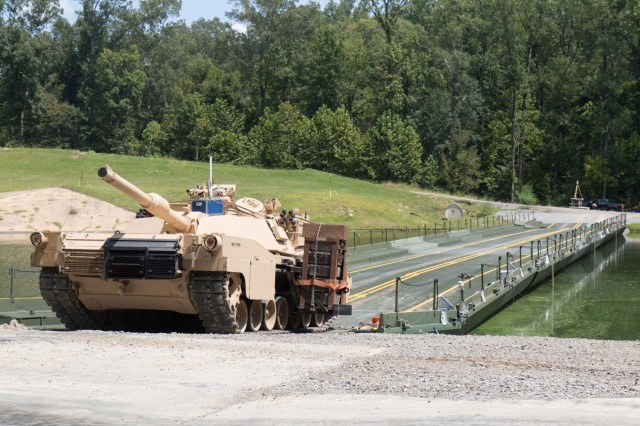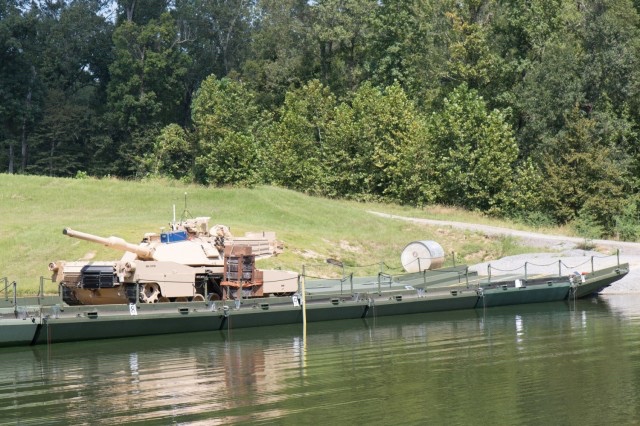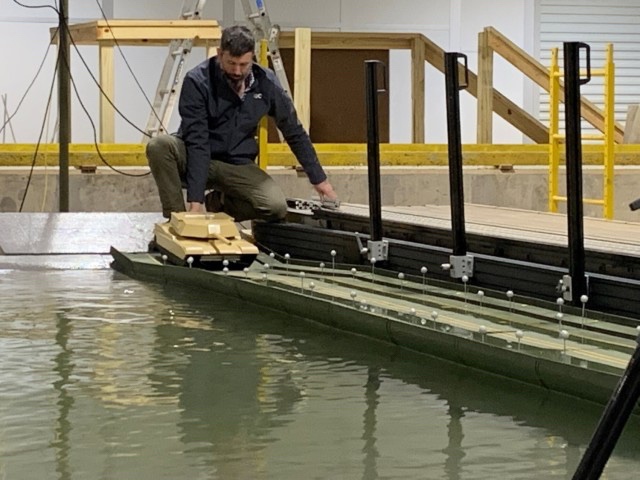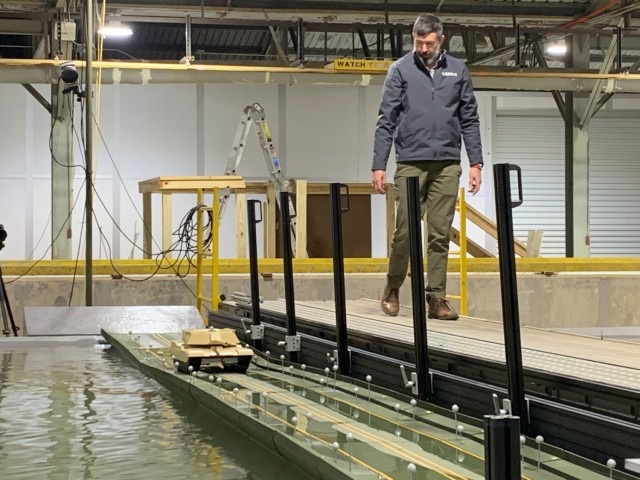
VICKSBURG, Miss. — In today’s ever-changing world, technology is advancing at lightning speed. For the U.S. Army that means constantly evolving vehicles, weapons and systems. With that in mind, the U.S. Army Engineer Research and Development Center, or ERDC, has partnered with the U.S. Army Program Executive Office Combat Support & Combat Service Support’s Project Manager Bridging to test high military load capacity vehicle weight limits of the Improved Ribbon Bridge, known as the IRB.
The IRB floating bridge system is used to transport weapon systems, troops and supplies over water when permanent bridges are not available. It provides wet-gap crossing capabilities either as a floating bridge or as a multi-bay raft for tracked and wheeled combat and tactical vehicles and has seen extensive combat operations with the Army and the U.S. Marine Corps since 2003.
“The family of high military load class bridging program is a program that we have here at ERDC that leverages subject matter experts across the ERDC to evaluate the structural response of the IRB when subjected to extreme loading conditions,” said Stephanie Robert, program manager and research civil engineer with the ERDC’s Geotechnical and Structures Laboratory. “We are able to look at the IRB and test it against different loading and hydrodynamic conditions to determine operational conditions in which the IRB can be deployed and subject it to increased weight and heavier vehicles.”

The multi-laboratory project reaches across the organization and includes personnel from the Mississippi Army National Guard and Anniston Army Depot. The project itself will span two years and has three testing phases: a full-scale still-water prototype test, a small-scale model test and computational modeling and analysis.
The first test phase, completed in September 2021, consisted of full-scale water testing of several military vehicles at various speeds and weights.
“We executed a fully successful test series with the IRB here at one of our testing basins,” said Dr. Wes Trim, a research mechanical engineer with ERDC Geotechnical and Structures Laboratory.
“The IRB is a complex float bridge system, and it’s difficult to test it under laboratory conditions,” he said. “We developed, designed and executed a full-scale still water test of the bridge, specifically aimed toward evaluating it against high military load capacity vehicles, by incrementally increasing our loading cases, not jumping into the heaviest most potentially damaging load first, but rather ramping up and taking a lot of measurements and inspections in between to safely approach our highest load targets.”

The team has since moved to the small-scale model testing phase of the project which will replicate the full-scale test and began in October 2021.
“We are going to take our results from our full-scale static flow testing, and we are going to validate it with our small-scale model testing,” said Robert.
“In full-scale, we had still water conditions, so there was no flow going through the channels,” she continued. “It was just the bridge out there, and we ran our vehicle across. Now we’re introducing hydrodynamic effects. We’re introducing river velocities and speeds across it that we didn’t test out in the field, so we’re able to bridge that gap.”
“We are doing scaled testing on the IRB,” said Dr. Duncan Bryant, a research hydraulic engineer with the ERDC’s Coastal and Hydraulics Laboratory. “We take a lot of care to make sure that we choose a scale where the hydrodynamic forces that we get here are captured and can be correlated up to a larger scale.”
The two tests are designed to complement each other with the small-scale test incorporating hydrodynamic aspects such as flow and depth.

“We can introduce river velocities, so we can ramp the river velocity up or down depending on what we are trying to simulate,” said Bryant. “As the water comes in, it impacts the IRB and changes the hydrodynamics. There is an operational space where it’s just too much flow for the bridge, and as you add more weight, that operational space changes. The way to do that safely is a scaled model. Here we don’t have to worry about sinking a tank or sinking a bridge, and we can try a lot of different scenarios out without any risk to anybody or any property.”
“We’re able to test conditions that we weren’t able to test in the full-scale here in a safe environment,” said Robert. “We’ll be able to determine river velocities. We’ll be able to determine max crossing speed of vehicles. We’ll be able to determine the type of crossings. We’ll be able to determine exactly how many bays we need in order to support the conditions that we are testing.”
The final phase of the project will begin when small-scale testing is complete. All data will go into a computational model to look at all loads and conditions the team was unable to test with the previous methods, which will allow the warfighter to know under what operational conditions they can safely cross the IRB.
The IRB is a robust bridge,” said Trim. “It has significant capability. It’s impressive the amount of load that it’s actually able to carry.”
By Carol Coleman


I am going to say something here and I will undoubtedly get roasted as an idiot but…. (nothing before “but” matters)
I understand the need and desire to promote your Program through the PIO Office and to seek continued funding but when you show specific tactical capabilities on social media (open source) isn’t this a terrible idea? Yes, this isn’t some TS level capability but I bet someone on here with engineering level education can tell me things from the text and photos that isn’t stated. Not knocking SSD, this info is available elsewhere, rather asking whether our media people need to step back and consider what they are releasing for open source publishing.
Roast away.
@jbgleason
Whilst I applaud your sensitivity to capability secrecy, I can’t see anything on here that tells me more than the fact that they have built a scale model to prove out the concept described in the copy. That said I’m not an engineer so maybe you’re right, I just can’t see it though.